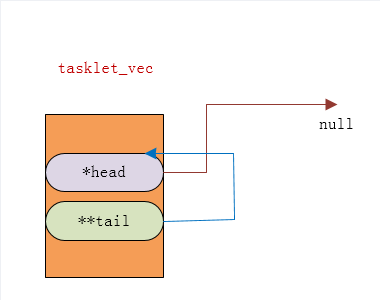Linux中断分层--软中断和tasklet
1. Linux中断分层

(1)上半部:当中断发生时,它进行相应的硬件读写,并“登记”该中断。通常由中断处理程序充当上半部。(一般情况下,上半部不可被打断)
(2)下半部:在系统空闲的时候,对上半部“登记”的中断进行后续处理(“延迟处理”)
2. 对于中断下半部的实现方式一共有三种
(1)软中断
(2)tasklet微线程
(3)工作队列
3. Linux内核软中断分析
(1)当中断发生时,Linux内核会跳转到中断总入口函数asm_do_IRQ(),根据传入的中断号,执行相应handle_irq()函数。做完这些工作之后,会调用函数irq_exit()(位于文件:kernal/softirq.c),该函数负责调用和处理待决的软中断。
- void irq_exit(void)
- {
- account_system_vtime(current);
- trace_hardirq_exit();
- sub_preempt_count(IRQ_EXIT_OFFSET);
- if (!in_interrupt() && local_softirq_pending())
- invoke_softirq();
- #ifdef CONFIG_NO_HZ
- /* Make sure that timer wheel updates are propagated */
- rcu_irq_exit();
- if (idle_cpu(smp_processor_id()) && !in_interrupt() && !need_resched())
- tick_nohz_stop_sched_tick();
- #endif
- preempt_enable_no_resched();
- }
(2)invoke_softirq()是一个宏,等价于do_softirq()。调用do_softirq函数,就说明程序已经进入软中断环境了。与asm_do_IRQ所处的中断的上半部不同,处于软中断环境中,是可以被其他中断程序打断的,甚至是处于同一中断线的中断。也因为此,所以软中断可以执行一些稍微时间长一点的任务,也不会迟滞系统对中断的反应时间。
(3)软中断由一个softirq_action结构体表示,在该结构体中只定义了一个函数指针
- struct softirq_action
- {
- void (*action)(struct softirq_action *);
- };
(4)Linux内核中用一个数据项为softirq_action类型的数组softirq_vec来存储所支持的所有软中断
- static struct softirq_action softirq_vec[NR_SOFTIRQS] __cacheline_aligned_in_smp;
(5)在驱动程序中,注册软中断使用函数open_softirq
- void open_softirq(int nr, void (*action)(struct softirq_action *))
- {
- softirq_vec[nr].action = action;
- }
(6)softirq_vec数组的下表代表不同类型的软中断,值越小,优先级越高,他们定义为一个枚举常量
- enum
- {
- HI_SOFTIRQ=,
- TIMER_SOFTIRQ,
- NET_TX_SOFTIRQ,
- NET_RX_SOFTIRQ,
- BLOCK_SOFTIRQ,
- TASKLET_SOFTIRQ,
- SCHED_SOFTIRQ,
- HRTIMER_SOFTIRQ,
- RCU_SOFTIRQ, /* Preferable RCU should always be the last softirq */
- NR_SOFTIRQS
- };
(7)驱动程序所要做的工作是把软中断注册进去,而执行是do_softirq调用一个名为Ksoftirq的内核线程来完成。我们如果想要执行我们注册的软中断,还需要调用raise_softirq函数将我们想要执行的软中断处理程序挂起
- void raise_softirq(unsigned int nr)
- {
- unsigned long flags;
- local_irq_save(flags);
- raise_softirq_irqoff(nr);
- local_irq_restore(flags);
- }
(8)相应类型的软中断被挂起之后,将会通过do_softirq得到执行
- asmlinkage void do_softirq(void)
- {
- __u32 pending;
- unsigned long flags;
- if (in_interrupt())
- return;
- local_irq_save(flags);
- pending = local_softirq_pending();
- if (pending)
- __do_softirq();
- local_irq_restore(flags);
- }
(9)do_softirq调用函数__do_softirq来真正执行软中断
- asmlinkage void __do_softirq(void)
- {
- struct softirq_action *h;
- __u32 pending;
- int max_restart = MAX_SOFTIRQ_RESTART;
- int cpu;
- pending = local_softirq_pending();
- account_system_vtime(current);
- __local_bh_disable((unsigned long)__builtin_return_address());
- trace_softirq_enter();
- cpu = smp_processor_id();
- restart:
- /* Reset the pending bitmask before enabling irqs */
- set_softirq_pending();
- local_irq_enable();
- h = softirq_vec;
- do {
- if (pending & ) {
- int prev_count = preempt_count();
- h->action(h);
- if (unlikely(prev_count != preempt_count())) {
- printk(KERN_ERR "huh, entered softirq %td %p"
- "with preempt_count %08x,"
- " exited with %08x?\n", h - softirq_vec,
- h->action, prev_count, preempt_count());
- preempt_count() = prev_count;
- }
- rcu_bh_qsctr_inc(cpu);
- }
- h++;
- pending >>= ;
- } while (pending);
- local_irq_disable();
- pending = local_softirq_pending();
- if (pending && --max_restart)
- goto restart;
- if (pending)
- wakeup_softirqd();
- trace_softirq_exit();
- account_system_vtime(current);
- _local_bh_enable();
- }
4. Linux内核tasklet分析
(1)软中断是将操作推迟到将来某一个时刻执行的最有效的方法。由于该延迟机制处理复杂,多个处理器可以同时并且独立得处理(即do_softirq函数可以被多个CPU同时执行),并且一个软中断的处理程序可以在多个CPU上同时执行,因此处理程序必须要被设计为完全可重入和线程安全的。此外临界区必须用自旋锁保护。软中断因为这些原因显得太过于麻烦,因此引入tasklet机制。
(2)tasklet是基于软中断实现的,确切的说应该是软中断的一个类型。所以根据软中断的性质,一个软中断类型对应一个软中断处理程序action。同理,也可以推出tasklet也会对应于一个唯一的action。
(3)每一个CPU都会有自己独立的tasklet队列,虽然一个tasklet类型的软中断只对应一个action处理程序,但是我们可以在该处理程序中轮询执行一个tasklet队列,队列里面的每一个tasklet_struct都会对应一个tasklet处理函数,这样当我们的驱动程序中需要使用到tasklet的时候,只要往这个tasklet队列加入我们自定义的tasklet_struct对象就可以了。同时,由于每一个CPU都会有一个tasklet队列,并且每一个CPU只会执行自己tasklet队列里面的tasklet_struct对象,因此tasklet并不需要自旋锁的保护(当然这只能是对同一个tasklet而言,如果多个不同的tasklet需要使用同一资源的话,仍需要自旋锁的保护)。
(4)Linux内核通过一个tasklet_struct结构体来描述一个tasklet对象,该结构体定义在include\linux\interrupt.h文件中
- struct tasklet_struct
- {
- struct tasklet_struct *next;
- unsigned long state;
- atomic_t count;
- void (*func)(unsigned long);
- unsigned long data;
- };
(5)tasklet的队列示意图
(5)Linux内核时通过名为tasklet_vec的tasklet_head结构体来组织tasklet对象的
- struct tasklet_head
- {
- struct tasklet_struct *head;
- struct tasklet_struct **tail;
- };
head:指向第一个tasklet_struct结构体的指针
tail:指向tasklet队列最后一个tasklet_struct的next指针的地址
(6)如果tasklet队列没有元素,两个指针的指向是这样的

(7)向tasklet队列添加tasklet_struct对象,就是将最后一个tasklet_sturct的next指针指向新加的tasklet_struct对象,同时将列表头的tail指针的指针指向新加的tasklet_struct结构体的next指针的地址。代码如下
- tasklet_struct * t;
- * _get_cpu_var(tasklet_vec).tail = t;
- _get_cpu_var(tasklet_vec).tail = &(t->next);
(8)tasklet类型的软中断唯一对应的action叫做tasklet_action(一般其他类型软中断的action都是由用户自己编写,但是tasklet不一样,Linux设计师已经帮我们实现了。所以也是因为这样,tasklet被广泛应用于驱动程序中)
- static void tasklet_action(struct softirq_action *a)
- {
- struct tasklet_struct *list;
- local_irq_disable();
- list = __get_cpu_var(tasklet_vec).head;
- __get_cpu_var(tasklet_vec).head = NULL;
- __get_cpu_var(tasklet_vec).tail = &__get_cpu_var(tasklet_vec).head;
- local_irq_enable();
- while (list) {
- struct tasklet_struct *t = list;
- list = list->next;
- if (tasklet_trylock(t)) {
- if (!atomic_read(&t->count)) {
- if (!test_and_clear_bit(TASKLET_STATE_SCHED, &t->state))
- BUG();
- t->func(t->data);
- tasklet_unlock(t);
- continue;
- }
- tasklet_unlock(t);
- }
- local_irq_disable();
- t->next = NULL;
- *__get_cpu_var(tasklet_vec).tail = t;
- __get_cpu_var(tasklet_vec).tail = &(t->next);
- __raise_softirq_irqoff(TASKLET_SOFTIRQ);
- local_irq_enable();
- }
- }
(9)另一个tasklet非常重要的函数,就是tasklet_schedule,这个函数通常用于中断处理程序中,用于将tasklet_struct加入所在CPU的tasklet队列,同时将tasklet软中断挂起。
因为我们知道,在中断的上半部中的irq_exit函数中,会激活do_softirq函数,所以在中断处理程序中使用tasklet_schedule函数就显得特别必要。tasklet_schedule源代码如下,
- static inline void tasklet_schedule(struct tasklet_struct *t)
- {
- if (!test_and_set_bit(TASKLET_STATE_SCHED, &t->state))
- __tasklet_schedule(t);
- }
test_and_set_bit(TASKLET_STATE_SCHED, &t->state):这个函数的目的是设置t->state的第TASKLET_STATE_SCHED(0)位,并返回t->state的第TASKLET_STATE_SCHED位原来的值。
(10)_tasklet_schedule函数:
- void __tasklet_schedule(struct tasklet_struct *t)
- {
- unsigned long flags;
- local_irq_save(flags);
- t->next = NULL;
- *__get_cpu_var(tasklet_vec).tail = t;
- __get_cpu_var(tasklet_vec).tail = &(t->next);
- raise_softirq_irqoff(TASKLET_SOFTIRQ);
- local_irq_restore(flags);
- }
(11)我们驱动程序中若要使用tasklet,首先我们还必须要创建一个tasklet_struct对象,通常创建tasklet_struct对象一共有两种方式:
① 静态方式:
- #define DECLARE_TASKLET(name, func, data) \
- struct tasklet_struct name = { NULL, , ATOMIC_INIT(), func, data }
- #define DECLARE_TASKLET_DISABLED(name, func, data) \
- struct tasklet_struct name = { NULL, , ATOMIC_INIT(), func, data }
② 动态方式:
- static struct tasklet_struct my_tasklet;
- tasklet_init(&my_tasklet, tasklet_handler, ); //count = 0,处于激活状态。
tasklet_init源码
- void tasklet_init(struct tasklet_struct *t,
- void (*func)(unsigned long), unsigned long data)
- {
- t->next = NULL;
- t->state = ;
- atomic_set(&t->count, );
- t->func = func;
- t->data = data;
- }
然后,我们再调用tasklet_schedule函数将tasklet对象加入到tasklet队列中即可。
Linux中断分层--软中断和tasklet的更多相关文章
- Linux中断分层技术
一.中断嵌套 当系统正在执行某中断处理函数时,又产生了一个新的中断,这就叫做中断嵌套.当中断为慢速中断时,新的中断会取代当前中断,即当前中断没有执行完就结束 了:当中断为快速中断时,新的终端就不会产 ...
- Linux中断分层--工作队列
1. 工作队列是一种将任务推后执行的方式,它把推后的任务交由一个内核线程去执行.这样中断的下半部会在进程上下文执行,他允许重新调度甚至睡眠.每个被推后的任务叫做“工作”,由这些工作组成的队列称为工作队 ...
- linux内核--软中断与tasklet
硬件中断通常都需要在最短的时间内执行完毕,如果将所有硬件中断相关的处理都放在硬件中断处理程序中,那么就达不到这个目的. 通过linux提供的软中断和tasklet,可以将硬件中断处理程序中可以延迟处理 ...
- Linux中断底半部机制
参考: Linux下半部处理之软中断 linux中断底半部机制 <深入理解Linux内核>软中断/tasklet/工作队列 软中断和tasklet介绍 详解操作系统中断 Linux内核:中 ...
- Linux中断管理 (2)软中断和tasklet
目录: <Linux中断管理> <Linux中断管理 (1)Linux中断管理机制> <Linux中断管理 (2)软中断和tasklet> <Linux中断管 ...
- linux中断源码分析 - 软中断(四)
本文为原创,转载请注明:http://www.cnblogs.com/tolimit/ 在上一篇文章中,我们看到中断实际分为了两个部分,俗称就是一部分是硬中断,一部分是软中断.软中断是专门用于处理中断 ...
- Linux内核中的软中断、tasklet和工作队列具体解释
[TOC] 本文基于Linux2.6.32内核版本号. 引言 软中断.tasklet和工作队列并非Linux内核中一直存在的机制,而是由更早版本号的内核中的"下半部"(bottom ...
- Linux软中断、tasklet和工作队列
Linux内核中的软中断.tasklet和工作队列详解 引言 软中断.tasklet和工作队列并不是Linux内核中一直存在的机制,而是由更早版本的内核中的“下半部”(bottom half)演变而来 ...
- Linux中断 - tasklet
一.前言 对于中断处理而言,linux将其分成了两个部分,一个叫做中断handler(top half),属于不那么紧急需要处理的事情被推迟执行,我们称之deferable task,或者叫做bott ...
随机推荐
- Oracle——SQL基础
一.SQL语句分为以下三种类型: DML: Data Manipulation Language 数据操纵语言DDL: Data Definition Language 数据定义语言DCL: Data ...
- 手机APP兼容性测试
兼容性测试方案 兼容性问题 屏幕分辨率兼容性问题 软件(iOS和Android系统版本及不同厂家的定制ROM)兼容性问题 硬件(不同的CPU.内存大小等等)兼容性问题 网络(2G/3G/4G/WIFI ...
- window7 Oracle卸载步骤
完全卸载oracle11g步骤:1. 开始->设置->控制面板->管理工具->服务(或 运行 services.msc) 停止所有Oracle服务.2. 开始->程序-& ...
- Robot Framework 使用总结
最近项目上使用了RF快速实现了一些验收测试的自动化case,感觉不错,很好用,下面就记录一下使用RF实现自动化的过程. 什么是RF? RF是一种测试框架,帮助测试人员在其框架下快速实现验收测试的自动化 ...
- select2的搜索框不能输入搜索内容
按照select2官网配置完后,搜索框弹出后无法输入内容,究竟怎么回事,于是在其他页面尝试了select2,发现可以啊,为什么在这个地方不可以,终于找到了造成这个问题的不同之处:select2在模态对 ...
- CentOS 网络操作
ifconfig:查看网卡信息 网卡配置文件位置: /etc/sysconfig/network-scripts/文件夹 nmtui:配置网卡 netstat -tlunp:查看端口信息 端口信息存储 ...
- angular 子路由
const routes: Routes = [ { path: '', redirectTo: '/home', pathMatch: 'full' }, { path: 'home', compo ...
- Android日期时间选择器DatePicker、TimePicker日期时间改变事件响应(Android学习笔记)
activity_main.xml <LinearLayout xmlns:android="http://schemas.android.com/apk/res/android&qu ...
- IDEA的一些常用快捷键以及配置
IDEA常用快捷键: 保存:ctrl + s 关闭当前文件:ctrl + F4 撤销:ctrl + z 反撤销:ctrl + shift + z 查看方法实现类:ctrl + alt + B 移动 ...
- 基于stor2RRD 的 SAN、存储监控
一. 配置用法在官网都有的详见网页: http://www.stor2rrd.com/install.htm?1.2 二 . 在这里我只是想记录一下我是如何编译安装Apache的,避免踩坑: 安装包如 ...
